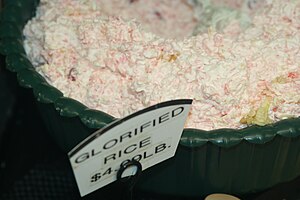Glorified rice
In today's world, Glorified rice is a topic that has gained great importance and has captured the interest of a large number of people. Whether due to its impact on society, its historical relevance, or its influence on popular culture, Glorified rice is a topic that does not leave anyone indifferent. Throughout history, Glorified rice has played a crucial role in the evolution of humanity, and its relevance remains evident in the modern world. In this article, we will thoroughly explore all facets of Glorified rice and examine its importance in today's society.
 Glorified rice at a supermarket in Minnesota | |
| Course | Dessert |
|---|---|
| Place of origin | United States |
| Region or state | Minnesota and the Upper Midwest |
| Serving temperature | Cold |
| Main ingredients | Rice, crushed pineapple, whipped cream |
Glorified rice is a dessert salad popular in the Midwestern cuisine served in Minnesota and other states in the Upper Midwest, United States[1][2] and other places with Norwegian populations.[citation needed] It is popular in more rural areas with sizable Lutheran populations of Scandinavian heritage.[citation needed] It is made from rice, crushed pineapple, and whipped cream.[2][3][4] It is often decorated with maraschino cherries.[5]
History
The long-established recipe has been the subject of many newspaper articles.[6] In 1995, Janet Letnes Martin and Suzann Nelson authored a humorous book comparing Lutheran and Catholic traditions called They Glorified Mary…We Glorified Rice: A Catholic–Lutheran Lexicon.[7][8] The book includes a recipe for glorified rice. The dish is also included in the title of Carrie Young's Prairie Cooks: Glorified Rice, Three-Day Buns, and Other Recipes and Reminiscences.[9] Glorified rice often turns up at potlucks and church picnics.[10][11]
See also
- Jello salad
- Watergate salad
- Snickers salad
- Cookie salad
- Midwestern cuisine
- Ambrosia (fruit salad)
- Risalamande, similar dish in Danish and other Scandinavian cuisine
- List of salads
References
- ^ Fertig, J. (2011). Prairie Home Cooking: 400 Recipes that Celebrate the Bountiful Harvests, Creative Cooks, and Comforting Foods of the American Heartland. America Cooks. Harvard Common Press. p. 223. ISBN 978-1-55832-145-8. Retrieved December 22, 2017.
- ^ a b Thielen, A. (2013). The New Midwestern Table: 200 Heartland Recipes. Potter/TenSpeed/Harmony. p. 332. ISBN 978-0-307-95488-6. Retrieved December 22, 2017.
- ^ Rice Journal. 1919. p. 27. Retrieved December 22, 2017.
- ^ Associated Rice Millers of California, Inc. (1984). The Bullseye, Volumes 2-3. New Orleans, LA. p. 24. Retrieved December 26, 2009.
{{cite book}}: CS1 maint: location missing publisher (link) - ^ Our Savior's Lutheran Church (1879-2004) 125 Years cookbook[page needed]
- ^ "Google News Archive of Glorified Rice stories". Retrieved January 26, 2009.
- ^ Martin, Janet Letnes; Nelson, Suzann (May 1995). Amazon entry on They Glorified Mary, We Glorify Rice. Redbird Productions. ISBN 0961343745.
- ^ "Excerpt from text at Lutheransonline.com". Archived from the original on May 27, 2011. Retrieved January 26, 2009.
- ^ Young, Carrie (7 May 1997). Amazon entry on Prairie Cooks: Glorified Rice, Three-Day Buns, and Other Recipes and Reminiscences by Carrie Young. HarperCollins. ISBN 0060927763.
- ^ "SIGN OF SPRING: GLORIFIED RICE February 25, 1998 St. Paul Pioneer Press (MN)". Retrieved January 26, 2009.
- ^ Wyman, C. (2001). Jell-O: a biography. Harvest Original. Harcourt. p. 125. ISBN 9780156011235. Retrieved December 22, 2017.